Ancient Promontory Forts
Ireland has a number of ancient forts which were created by building defences across a spur of land jutting out to sea. This method reduced the work of building defences by about 75%, as an approach could only be made by land. An inland variation of this technique used precipices rather than sea-cliffs as the natural defences.
Dating of these structures is difficult, but they are believed to be of the Iron Age, which in Ireland was about 500BC to 500AD. Some may date back as far as the Late Bronze Age, about 800BC.
Even more difficult is the determination of the precise function of these 'forts'. It is possible that the largest structures were a focus for ceremony rather than defence.
So little is known that it may be best for the curious to go to the sites and try to stand in the shoes of the builders. Look not only at the sites, but at the countryside and natural features around them.
Cathair Con Rí
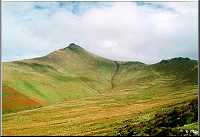 |
About half-way down the Dingle Peninsula, above the village of Camp, is the promontory hill fort of Cathair Con Rí. This view from below shows the near-vertical cliff at the very top. (Well OK, it shows it if you click the small picture and look closely at the larger picture. The picture was taken from about 2000 ft below.) |
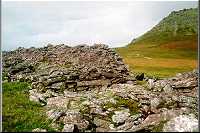 |
At the top, a wall 110 metres long has been built across the neck of flattish land to enclose an area of about 2 acres. The wall would have been 3 metres high and 4 metres thick, rising from the inside in steps.
There are two openings in the wall. One is shown in the picture on the left. |
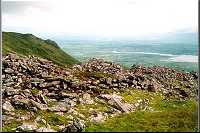 |
2500 years of exposure on a windy mountain have not been kind to the wall. This picture of a better-preserved wall at Dún Beag (Dunbeg; 'small fort'), a smaller coastal promontory fort out beyond Dingle gives a better impression.
Note the steps up to the defenders positions. |
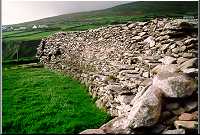 |
Building such a wall at this altitude simply for defence seems more than a little excessive. An experience of the view, however, may be enough to persuade us that the people who marked this place saw it as a place for gods, heroes and kings.
Click on the strip to see a full version of the panorama. It's 173k, but worth waiting for. (WebTV won't show the full size image apparently.)
Some day I'll go back and get better-controlled versions between sunrise and sunset.

The Mythology of Cathair Con Rí
- To be added -
The Illusion of Safety
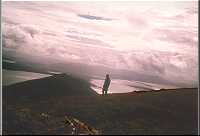 I went up to the fort alone, in October. This is of course considered to be the height of foolishness by people who know better, including myself.
I went up to the fort alone, in October. This is of course considered to be the height of foolishness by people who know better, including myself.
Don't do this at home kids! Even if you have let people know, carry survival gear, have map, compass, etc., and stop to get a feel for the contours, a bank of cloud will close in suddenly and you'll end up in a rapid descent or with a twisted foot.
But then, look at the plus side.
You are on your own, in a very lonely place, with just yourself and the universe to consider. Go ahead! Take your 20th/21st century clothes off to heighten the effect. Stand there, look around and consider the possibility of humankind controlling any of this.
Ah but then; look at the minus side
As you lay there, naked as the day you were born,
- You realise that the coarse mountainy grass is wet and spikey.
- You get hypothermia.
- You look up to find that you have been joined by a party of (fully-dressed) nuns. (Happened to me and my lady once, as we nippy-dipped in a mountain lake.)
- You are surrounded by a mountain rescue team; all kitted up with satellite navigation, helicopters and TV cameras. They want to take you down on a stretcher. You object, so they get their doctor to commit you to the house for the bewildered.
But then again, think of the plus side!
Back to Archaeology
Web Design by ALIA




